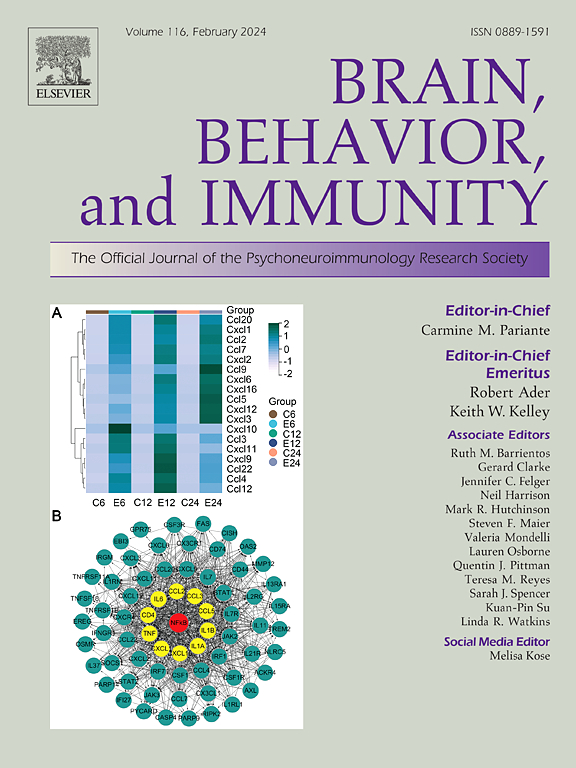Interleukin-6 produces behavioral deficits in pre-pubescent mice independent of neuroinflammation
IF 8.8
2区 医学
Q1 IMMUNOLOGY
引用次数: 0
Abstract
Maternal inflammation during pregnancy increases the offspring’s risk of developing autism, ADHD, schizophrenia, and depression. Epidemiologic studies have demonstrated that maternal infections stimulate the production of interleukin-6 (IL-6), which can cross the placenta and fetal blood–brain barrier to alter brain development with functional and behavioral consequences. To model the effects of increased IL-6 between weeks 24–30 of human gestation, we injected male and female mice with 75 ng IL-6 twice daily, from P3 to P6. Our published studies have shown that this increases circulating IL-6 two-fold, alters post-pubescent ultrasonic vocalization patterns, reduces sociability, and increases self-grooming.
However, most neurodevelopmental disorders in humans manifest in children as young as 2 years of age. Hence, a critical unexplored question is whether behavioral changes in immune activation models can be detected in pre-pubescent mice. Therefore, we evaluated early communication, sociability, and repetitive behaviors in pre-pubescent mice following the IL-6 treatment. A second open question is whether the cellular and behavioral changes are secondary to systemic or neuroinflammation. To address this question, we profiled 18 cytokines and chemokines in the circulation and CNS and evaluated eight immune cell types in P7 male and female brains following systemic IL-6 administration. We found an increase in ultrasonic vocalizations with simpler morphologies produced by the IL-6-injected male pups and a decrease in frequency in the female vocalizations upon removal from the nest at P7. The IL-6-treated male pups also socially interacted less when introduced to a novel mouse vs. controls as juveniles and spent almost twice as much time grooming themselves, a phenotype not present in the females. Tactile sensitivity was also increased, but only in the IL-6-treated female mice. The IL-6-treated mice had increased circulating IL-6 and IL-7 and reduced IL-13 at P7 that were no longer elevated at P14. There were no changes in brain levels of IL-6, IL-10, IL-13 or IL-17A mRNAs at P7. Altogether, these studies show that changes in the three core behavioral domains associated with several psychiatric disorders can be detected early in pre-pubescent mice following a transient developmental increase in IL-6. Yet, these behavioral alterations do not require neuroinflammation.
求助全文
约1分钟内获得全文
求助全文
来源期刊
CiteScore
29.60
自引率
2.00%
发文量
290
审稿时长
28 days
期刊介绍:
Established in 1987, Brain, Behavior, and Immunity proudly serves as the official journal of the Psychoneuroimmunology Research Society (PNIRS). This pioneering journal is dedicated to publishing peer-reviewed basic, experimental, and clinical studies that explore the intricate interactions among behavioral, neural, endocrine, and immune systems in both humans and animals.
As an international and interdisciplinary platform, Brain, Behavior, and Immunity focuses on original research spanning neuroscience, immunology, integrative physiology, behavioral biology, psychiatry, psychology, and clinical medicine. The journal is inclusive of research conducted at various levels, including molecular, cellular, social, and whole organism perspectives. With a commitment to efficiency, the journal facilitates online submission and review, ensuring timely publication of experimental results. Manuscripts typically undergo peer review and are returned to authors within 30 days of submission. It's worth noting that Brain, Behavior, and Immunity, published eight times a year, does not impose submission fees or page charges, fostering an open and accessible platform for scientific discourse.

 求助内容:
求助内容: 应助结果提醒方式:
应助结果提醒方式:


